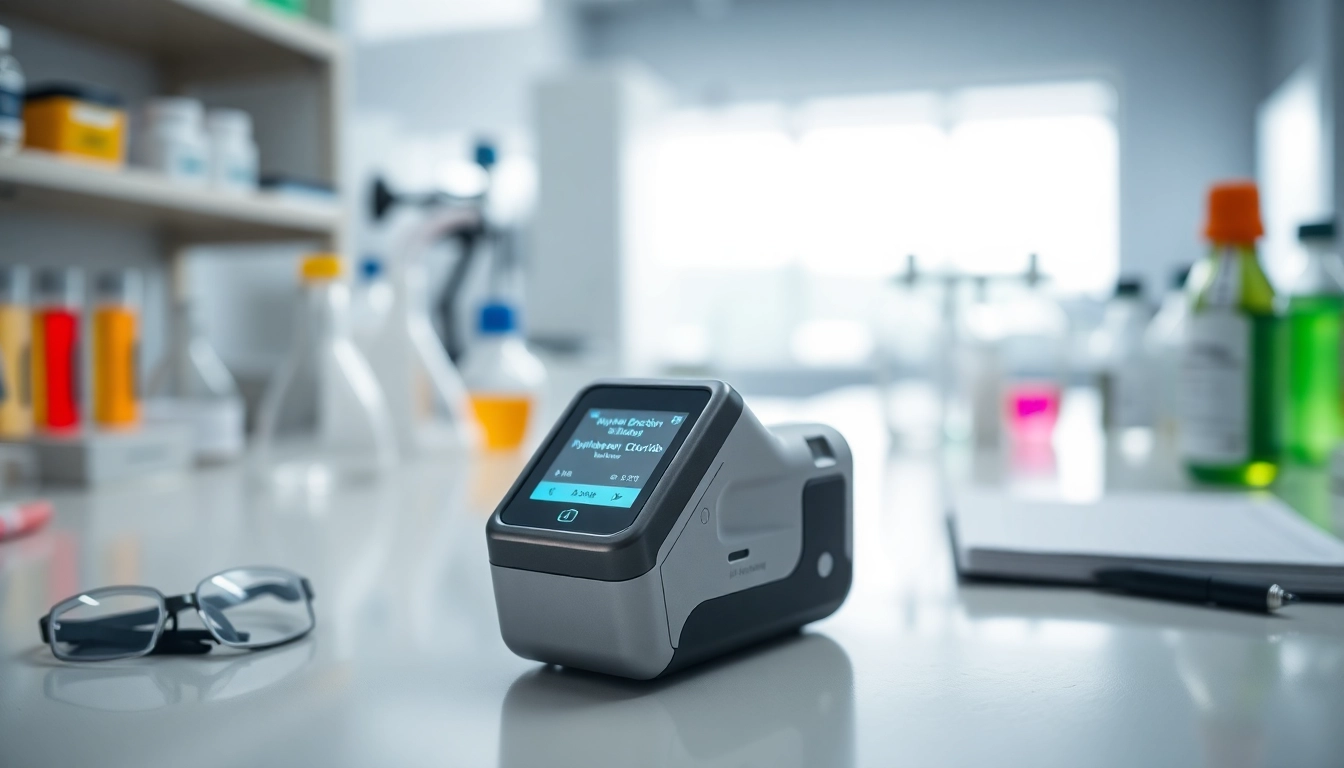
Introduction to Hydrogen Chloride Detectors
What is a Hydrogen Chloride Detector?
A Hydrogen Chloride detector is a specialized tool designed to identify and measure the presence of hydrogen chloride (HCl) gas in the environment. This type of detector operates through various methods, including electrochemical sensors, infrared spectroscopy, or photoionization detectors. Given the hazardous nature of hydrogen chloride, proper detection is critical in numerous industrial applications. These detectors provide real-time readings that can help prevent exposure and maintain a safe working environment.
The Importance of Hydrogen Chloride Detection
Hydrogen chloride is a colorless gas that can form hydrochloric acid when combined with water. It is corrosive and poses significant health risks, such as respiratory issues and skin burns, making the detection of this substance vital in various industries. In environments where HCl is used or generated, the implementation of a Hydrogen Chloride detector can enhance safety protocols, thus preventing accidents and ensuring compliance with health and safety regulations. Reliable detection not only safeguards employees but also protects equipment and facilities from potential damage.
Key Features of Modern Hydrogen Chloride Detectors
Modern Hydrogen Chloride detectors come equipped with advanced features that enhance their functionality and reliability. Some key features include:
- Real-time Monitoring: Continuous monitoring capabilities allow for immediate detection of HCl gas levels.
- Data Logging: Many detectors can record data over time, enabling analysis of gas exposure trends and compliance with safety standards.
- Alarm Systems: Integrated alarms provide immediate alerts to the presence of hazardous gas levels, facilitating prompt response and action.
- Portability: Wireless and portable models are available, offering flexibility for on-the-go monitoring and inspection.
Understanding Hydrogen Chloride and Its Risks
Properties and Hazards of Hydrogen Chloride
Hydrogen chloride is a highly soluble and corrosive gas, often produced through industrial processes, such as the manufacturing of polymers and other chemicals. Its properties include:
- Physical State: Colorless gas at room temperature.
- Odor: Pungent and irritating, detectable at low concentrations.
- Corrosiveness: Can damage tissues and materials upon contact.
- Health Effects: Exposure can lead to respiratory distress, throat irritation, and ocular injury.
Due to these properties, any workplace where hydrogen chloride is present must prioritize effective detection and management protocols to mitigate health risks.
Common Industries Requiring Detection
Several industries involve the use of hydrogen chloride, highlighting the necessity for robust detection systems. These industries include:
- Chemical Manufacturing: Where HCl is used in various chemical reactions and processes.
- Petrochemical Industry: Involved in oil refining where hydrogen chloride is produced as a byproduct.
- Wastewater Treatment: HCl is commonly used in treating industrial waste streams.
- Pharmaceuticals: Used for chemical synthesis and pH adjustment in production processes.
Identifying Exposure Risks
Identifying exposure risks associated with hydrogen chloride is crucial for maintaining safety. Industries must conduct regular risk assessments to evaluate:
- Point of Use: Areas where HCl is stored or utilized can experience leaks.
- Transport and Handling: The process of moving and handling HCl containers poses risks of spills or leaks.
- Environmental Factors: Temperature and pressure fluctuations can contribute to the release of gas.
Employing robust detection systems mitigates these risks and enhances employee awareness and safety protocols.
How to Select the Right Hydrogen Chloride Detector
Factors to Consider in Selection
Choosing the right Hydrogen Chloride detector involves careful consideration of various factors to ensure its effectiveness. Key aspects to evaluate include:
- Detection Range: Consider the concentration levels expected in the workplace to select a detector with appropriate sensitivity.
- Response Time: A rapid response time is crucial in hazardous environments where immediate action may be required.
- Calibration Needs: Understand the calibration frequency necessary for accurate readings and ease of maintenance.
- Usage Environment: Assess factors such as temperature, humidity, and potential exposure to other chemicals that may impact performance.
Top Brands and Models for Effective Monitoring
Several reputable brands offer high-quality Hydrogen Chloride detectors designed for industrial applications. Some top models include:
- RAE Systems QRAE 3: Features multiple gas detection capabilities, including HCl, with a robust data logging system.
- Drager X-am 5000: A portable detector known for its reliability and real-time monitoring capabilities.
- Honeywell GasAlert Micro 5: Offers advanced features for workplace safety, including visual and audible alarms.
These models are designed to meet the rigorous demands of industries utilizing hydrogen chloride, providing peace of mind through effective monitoring.
Comparative Analysis of Detector Technologies
To ensure you select the optimal Hydrogen Chloride detector, it is essential to understand the different technologies available. Each technology comes with distinct advantages and limitations:
- Electrochemical Sensors: Sensitive to low concentrations; ideal for personal monitoring but can be influenced by environmental conditions.
- Infrared Spectroscopy: Highly accurate and less affected by humidity; suitable for continuous monitoring in stable environments.
- Photoionization Detectors: Effective for real-time monitoring of various gases, including volatile organic compounds; however, they can be more expensive.
The selection of detection technology should align with the specific requirements of the workspace and the nature of hydrogen chloride exposure.
Best Practices for Using Hydrogen Chloride Detectors
Installation Recommendations
Proper installation of Hydrogen Chloride detectors is crucial for their performance. Follow these best practices:
- Location: Place detectors in areas where hydrogen chloride is used or generated, ensuring they are unobstructed by equipment.
- Height: Install at a height that coincides with the expected levels of gas; since HCl is denser than air, lower installations may be necessary.
- Regular Site Assessments: Conduct periodic evaluations to adjust detector placements based on changes in workplace layout or processes.
Calibration and Maintenance Procedures
Regular calibration and maintenance of Hydrogen Chloride detectors ensure accurate performance. Implement the following procedures:
- Scheduled Calibration: Follow manufacturer guidelines for calibration frequency, usually every six months to one year.
- Battery Checks: Regularly inspect and replace batteries to prevent operational failures.
- Sensor Replacement: Monitor sensor performance, as they can degrade over time; replacing them as needed ensures continuous functionality.
Training for Effective Use and Response
Comprehensive training for employees on the use of Hydrogen Chloride detectors is essential. Key training components include:
- Detector Operation: Ensure all personnel know how to operate detectors effectively and understand the importance of real-time monitoring.
- Emergency Response: Conduct drills that familiarize staff with emergency protocols in case of HCl gas presence, including evacuation routes and protective equipment.
- Reporting Procedures: Train employees to recognize alarms and report irregularities promptly to ensure swift response actions.
Evaluating Detector Performance and Compliance
Key Performance Metrics to Track
To evaluate the efficacy of Hydrogen Chloride detectors, organizations should monitor specific performance metrics, including:
- Detection Accuracy: Measure the accuracy of the readings against known concentrations of HCl.
- Response Time: Document the time taken for detectors to respond to HCl presence, as rapid detection enhances safety.
- Operating Life: Track the lifespan of detectors and sensors to ensure reliability in long-term use.
Compliance with Safety Regulations
Ensuring compliance with federal and state regulations regarding hydrogen chloride is essential for workplace safety. Organizations should:
- Stay Updated: Regularly review guidelines established by OSHA (Occupational Safety and Health Administration) and ANSI (American National Standards Institute) for any updates.
- Conduct Audits: Implement routine safety audits to verify that hydrogen chloride detection practices meet regulatory standards.
- Documentation: Maintain accurate records regarding detector calibration, maintenance, and training, which can be valuable during compliance inspections.
Ensuring Reliable Data Collection for Safety Analytics
Reliable data collection is crucial for effective safety analytics and risk management. Organizations should implement the following strategies:
- Automated Data Logging: Utilize detectors that automatically log data for trend analysis and reporting.
- Regular Reviews: Schedule periodic reviews of logged data to assess exposure risks and identify preventive measures.
- Integrating Analytics Tools: Leverage software tools for data analysis that can help detect patterns and facilitate strategic safety decisions.







